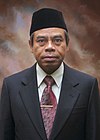Imerisi-Tarangara
Imerisi-Tarangara | |
|---|---|
| Capital | Rapava |
| Largest | Kajasa |
| Ethnic groups (2018) |
|
| Demonym(s) | Imerisene Tarangaran |
| Government | Federal semi-presidential republic |
| Kokhta Kherkheulidze | |
| Komalo Siale | |
| Anzor Akhalkatsi | |
| Legislature | Parliament |
| Darbazi | |
| Karavi | |
| Establishment of Nationhood | |
| 1821 | |
| 1855 | |
| 1985 | |
| Population | |
• 2019 census | 3,516,744 |
| GDP (PPP) | estimate |
• Total | $144.981 billion |
• Per capita | $41,226 |
| GDP (nominal) | estimate |
• Total | $152.974 billion |
• Per capita | $43,499 |
Imerisi-Tarangara (Khamli: იმერისი-ტარანგარა Imerisi-T’arangara; Talai: ꦆꦩꦶꦫꦶꦱꦶ-ꦡꦄꦫꦄꦤꦒꦄꦫꦄ Imirisi-Tarangara; Moi: ꦇꦩꦼꦫꦶꦱꦶ-ꦠꦄꦫꦄꦤꦒꦄꦫꦄ Imerisi-Tarangara) is an island country located in the Demontean Ocean. It consists of over 450 islands, of which the two largest and main are Takhti, the western island, and Kvertkhi, the eastern island. Its population of 3.5 million is largely urbanised, and mainly located in the north and south-east of Takhti. Its capital is Rapava, and its largest city is Kajasa
The first indigenous Tarangarans arrived around 45,000 to 42,000 years ago in several waves. Later in 300 CE Deuteric-speaking peoples arrived and largely settled the north of Takhti and various islands, intermixing and fusing with the native Tarangaran culture. From 900 CE to 1600 CE the islands flourished as they set up mercantile lanes between Isuan, Idica, and the Straits of something. The kingdoms of Mangasara, Koor, and Kawiari became dominant, particularly Mangasara which until the late 17th century maintained a loose hegemony over the islands. From the 15th century onwards Macakkanism arrived from Isuan and by the 19th century the majority of Tarangarans had converted.
The islands were first visited in 1558 by Tancredo Venturi, an Esmerian explorer serving the Blaykish crown. He named them Albertiane after Albert VII and established relations with Mangasara and several other polities. Over the 17th and 18th centuries Blayk and other Auressian powers established various forts and relations. A changing climate and incessant warfare had weakened the native Tarangaran kingdoms, and Auressian powers further pitted them against one another. By the 19th century the islands were of decreasing importance due to their remoteness, and most Auressian powers abandoned their outposts.
During the 18th and 19th centuries the diasporic Rasmi intelligentsia began longing for a homeland. Earlier attempts in the New World had failed, and the debate raged around finding a new land or attempting to resettle Ancient Argetia. Agustin Rapava founded the Rapava Enterprise, purchased land in Albertiane from the deposed Gilbert II in 1805 and began encouraging immigration to the new settlement of Rapava. The Enterprise purchased more land, and established treaties with native Tarangarans, until in 1821 it declared a new nation, Imerisi. In 1855 a conference held at Montigné saw Imerisi recognised as a Rasmi nation and all lands in the islands were ceded or sold, and all treaties with the native polities transferred. During the 19th centuries the remaining native polities were slowly integrated or annexed. During the Second Great War Imerisi was occupied by Songha from 1938 to 1943. Calls by Tarangarans for equality and recognition grew during the 20th century, culminating in a new constitution promulgated in 1985 which changed the country's name to Imerisi-Tarangara and removed any reference to its status as a Rasmi state.
Some stuff here about how great the QoL is, except not as much for the Tarangarans and rural peeps. Also government stuff.
A small line here about any alliances, groups, and stuff Imerisi is a part of.



